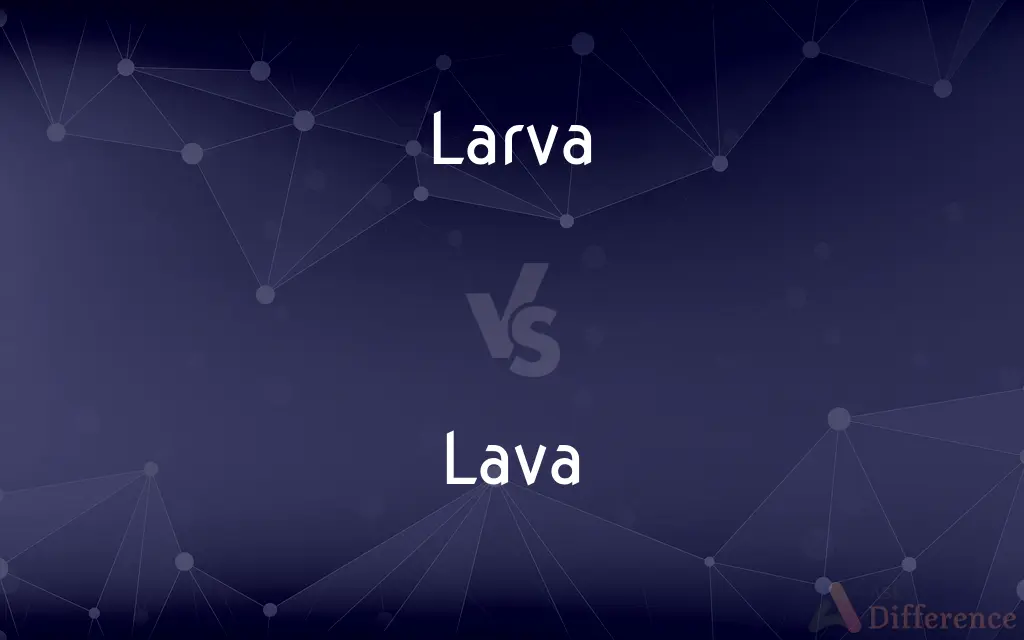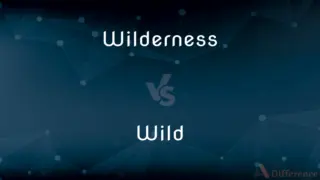Larva vs. Lava — What's the Difference?
By Urooj Arif & Fiza Rafique — Updated on April 18, 2024
Larva refers to the immature form of an insect that undergoes metamorphosis, while lava is molten rock expelled by a volcano during an eruption.

Difference Between Larva and Lava
Table of Contents
ADVERTISEMENT
Key Differences
Larva is a developmental stage in the life cycle of insects, where the organism is typically worm-like and primarily focused on feeding and growth. On the other hand, lava is a geological phenomenon, consisting of molten rock that emerges from the Earth during volcanic eruptions and cools to form new rock formations.
Larvae often undergo several molts before reaching adulthood, undergoing significant physical changes throughout their development. Whereas lava, once expelled, undergoes cooling and solidification, changing from liquid to solid state as it forms igneous rock.
The habitat of a larva varies widely depending on the species, often found in aquatic or terrestrial environments that provide ample food sources. In contrast, lava flows are typically found in volcanic regions, shaping the landscape as they move and cool.
Larvae play crucial ecological roles, often serving as primary consumers in their food chains and supporting biodiversity by participating in the decomposition of organic matter. Conversely, lava contributes to the geological cycle, creating new landforms and altering ecosystems through both destruction and the creation of new habitats.
The study of larvae is important in entomology, particularly for understanding the life cycles and ecological impact of insect species. On the other hand, the study of lava is a key aspect of volcanology, aiding in understanding Earth's internal processes and the dynamics of volcanic eruptions.
ADVERTISEMENT
Comparison Chart
Definition
Immature stage of an insect.
Molten rock expelled by volcanoes.
State
Solid, organic.
Liquid (molten), inorganic.
Role in Ecosystem
Supports biodiversity, decomposes matter.
Forms new landforms, alters ecosystems.
Habitat
Aquatic, terrestrial environments.
Volcanic regions.
Study Discipline
Entomology.
Volcanology.
Compare with Definitions
Larva
Plays a vital role in food webs, often as prey for various predators.
Fish frequently feed on aquatic larvae.
Lava
Upon cooling, it solidifies to form igneous rock.
Basalt is a type of rock commonly formed from lava.
Larva
An early, usually worm-like stage of an insect’s lifecycle.
The larva of the butterfly is commonly called a caterpillar.
Lava
Its temperature can reach up to 1,250 degrees Celsius.
The lava from a shield volcano is typically very hot and fluid.
Larva
Typically characterized by high growth rates, consuming large amounts of food.
Moth larvae are voracious eaters of fabrics.
Lava
Studied to understand geological and environmental processes.
Volcanologists study lava to predict future volcanic eruptions.
Larva
Undergoes metamorphosis to become an adult.
Mosquito larvae develop in water before emerging as adults.
Lava
Molten rock that reaches the earth's surface through volcanic vents.
Lava flows are a common sight during volcanic eruptions.
Larva
Found in diverse habitats tailored to specific survival needs.
Beetle larvae often live inside decaying wood.
Lava
Affects geographical and ecological landscapes by creating new formations.
Lava flows can create natural barriers like lava tubes and fields.
Larva
The newly hatched, wingless, often wormlike form of many insects, developing into a pupa in species that undergo complete metamorphosis.
Lava
Lava is molten rock (magma) that has been expelled from the interior of a terrestrial planet (such as Earth) or a moon. Magma is generated by the internal heat of the planet or moon and it is erupted as lava at volcanoes or through fractures in the crust, usually at temperatures from 800 to 1,200 °C (1,470 to 2,190 °F).
Larva
The six-legged immature form of a tick or mite.
Lava
Molten rock that reaches the earth's surface through a volcano or fissure.
Larva
Roman Mythology A malevolent spirit of the dead.
Lava
The rock formed by the cooling and solidifying of molten rock.
Larva
An early stage of growth for some insects and amphibians, in which after hatching from their egg, insects are wingless and resemble a caterpillar or grub, and amphibians lack limbs and resemble fish.
Lava
The molten rock ejected by a volcano from its crater or fissured sides.
Larva
An animal in the aforementioned stage.
Lava
Magma.
Larva
(figurative) A preliminary stage of someone or something, before it has fully matured, especially a time of growth rather than one of performance.
Lava
A shade of red, named after the volcanic lava.
Larva
The early, immature form of any animal when more or less of a metamorphosis takes place, before the assumption of the mature shape.
Lava
The melted rock ejected by a volcano from its top or fissured sides. It flows out in streams sometimes miles in length. It also issues from fissures in the earth's surface, and forms beds covering many square miles, as in the Northwestern United States.
Larva
The immature free-living form of most invertebrates and amphibians and fish which at hatching from the egg is fundamentally unlike its parent and must metamorphose
Lava
Rock that in its molten form (as magma) issues from volcanos; lava is what magma is called when it reaches the surface
Common Curiosities
What is the difference between larva and lava?
A larva is an immature stage of an insect, while lava is molten rock from a volcano.
Can all insects form larva?
Not all; only insects that undergo complete metamorphosis, such as butterflies and beetles, have larval stages.
Why is lava dangerous?
Lava is extremely hot and can cause fires and destruction over wide areas.
What happens to lava after it cools?
It solidifies into igneous rock, often forming new landscapes and habitats.
How do larvae contribute to the ecosystem?
Larvae decompose organic material and serve as important food sources for other species.
What do larvae eat?
Their diets can vary widely; some eat plants, while others consume animal matter or decomposing organic substances.
What types of lava are there based on viscosity?
Lava types include pahoehoe (smooth and ropey) and a'a (rough and jagged), based on their viscosity and cooling processes.
Are larvae only found in water?
No, larvae can be terrestrial or aquatic, depending on the species.
What does the color of lava indicate?
Generally, red-hot lava is cooler, while white-hot lava indicates extremely high temperatures.
Is it possible to predict when a larva will metamorphose?
Predictions can be made based on species-specific growth rates and environmental factors.
How is larva used in science?
Studying larvae helps scientists understand biodiversity, life cycles, and the impacts of environmental changes.
What factors affect the flow of lava?
Temperature, chemical composition, and slope of the terrain influence how lava flows.
What is the significance of studying lava?
It helps in understanding Earth's internal structure and the dynamics of its crust.
Can lava create islands?
Yes, lava flows can form islands, especially in oceanic volcanic regions.
Do larvae have predators?
Yes, many species, including birds, fish, and other insects, prey on larvae.
Share Your Discovery

Previous Comparison
Wilderness vs. Wild
Next Comparison
Cardiomegaly vs. CardiomyopathyAuthor Spotlight
Written by
Urooj ArifUrooj is a skilled content writer at Ask Difference, known for her exceptional ability to simplify complex topics into engaging and informative content. With a passion for research and a flair for clear, concise writing, she consistently delivers articles that resonate with our diverse audience.
Co-written by
Fiza RafiqueFiza Rafique is a skilled content writer at AskDifference.com, where she meticulously refines and enhances written pieces. Drawing from her vast editorial expertise, Fiza ensures clarity, accuracy, and precision in every article. Passionate about language, she continually seeks to elevate the quality of content for readers worldwide.














































